Far Gate Preview
This space-combat sim has been a long time in development. Read on for our impressions of the latest build.
Why have there been so few epic starship fleet battles in movies and computer gaming? Why has it proven to be so difficult to depict dueling fleets of intimidating dreadnoughts, sleek frigates, imposing carriers and nimble fighter craft on screens and monitors, when massive interstellar battles pervade science-fiction novels? We're far more likely to get intimate, small-scale cinematic jousts like Khan vs. Kirk in Star Trek II than Return of the Jedi's elaborate melees. Movies have historically been forced to limit the scale and duration of starship battles because of the intimidating costs associated with depicting larger scale engagements, but game developers seem to have needlessly imposed similar scope restrictions on their creations.
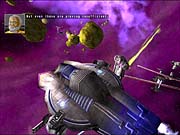
Starship battles in computer games have historically seemed deliberately restrained in scope, typically involving only a handful of vessels battling an equal number of similar foes. Space sims generally limit their scale by focusing almost exclusively on small fighter craft, with larger capital ships functioning solely as exotic targets, and science fiction games in other genres have focused almost exclusively upon terrestrial battles.
During the past couple of years that's finally begun to change. Strategy games such as Relic's Homeworld and Interplay's Starfleet Command series have capably demonstrated just how entertaining it is to assemble wings of battleships in order to stalk, outmaneuver and thrash similarly formidable alien fleets. Hoping to improve upon the experiences offered by those games, Seattle-based developer SuperXstudios has been working on Far Gate, a real-time strategy game that emphasizes grand scale fleet battles between the forces of three very distinctive races.
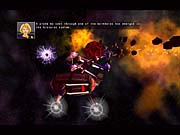
Far Gate is a real-time strategy game that resembles the Homeworld games in a number of notable ways. Like those games, Far Gate features true 3D maps, requiring you to deploy your forces and plot your machinations in 3D space. While games such as Digital Anvil's somewhat similar upcoming fleet battle game, Conquest: Frontier Wars, and Starcraft occasionally convey the illusion that units are moving at varying heights, their battlefields are actually flat two-dimensional environments. Far Gate's 3D environments are present additional tactical opportunities and look incredible, replete with asteroid fields, planets of varying sizes and shapes, colorful nebulae and burning suns, but their complexity also makes them potentially more difficult to interpret and navigate.
Fortunately, like the Homeworld games, Far Gate features a well-designed and customizable interface that lets you access desired information quickly and conveniently and control your ships as you maneuver them through 3D space. There are a number of hotkeys that let you quickly shift your perspective to better assess your tactical situation. Each ship or task force has a limited sensor range, which is conveniently represented by an encompassing green circle. While you'll always be able to see celestial objects, such as asteroids and planets, you won't see enemy ships or installations that aren't currently within range of your ships' sensors. You can improve your reconnaissance by creating probes, which will quickly be reduced to atoms if they get detected by enemy ships.
You can control ships either as squads or individually, and you can immediately hop to a strategic overhead view of the surroundings or zoom the camera perspective behind any ship, granting you a close look at the action. It's an interface that works well in practice, ensuring that you'll constantly get to sample the game's detailed graphics without ever having to compromise your ability to control your forces.
Enter the Evil Crystals
The game's plot commences 15 years after a pilot expedition left our solar system to found Earth's first colony on another planet. To the chagrin of the expedition participants, when they arrive at their destination they discover that the atmosphere of their intended home has been rendered inhospitable, and the solar system is infested by the Nue-Guyen, a strange alien race that uses organic ships. You are cast in the role of Jacob Viscero, an ex-black-market smuggler who has been conscripted to command the initially poorly equipped militia of the expedition.
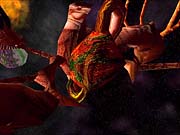
The plot of the game is advanced in traditional RTS fashion, through cinematics that bookend the beginning and conclusion of each mission, but the presentation of the cinematics is novel. Your protagonist and the other characters are represented through cartoonish portraits, and the voice acting is similarly caricatured. The cast of characters seems like it was extracted straight from a histrionic anime: There are blustering admirals who trumpet the superiority of their fleet's weaponry; naive but well-intentioned scientists; and faction leaders who are either supremely altruistic or entirely corrupt. The plot should contain a few twists, as allegiances are bound to shift when the true motivations of certain groups are unveiled, but the storyline will always emphasize lighthearted melodrama. Characters should consistently live up to your lowest expectations, and usually to humorous effect. Those crazy maniacal egotists are always causing trouble.
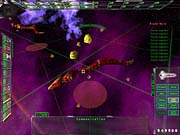
In addition to the organic Nue-Guyen, there's a third and similarly mysterious race, the crystalline Entrodii. Ship design looks excellent, and the developers have promised that each of the three races will have 25 distinctive units. The human ships range from small fighter craft to tug ships equipped with tow cables to battleships that resemble their seafaring counterparts. The Nue-Guyen ships also look like they emigrated from the sea and are shaped like eels, worms, and more monstrous beasts. The Entrodii craft look, naturally, like giant crystals in varying sizes and configurations. If you remember the ship that ferried baby Kal-el to Earth in the original Superman movie you'll have a pretty good idea of how the Entrodii vessels look, except the Entrodii are considerably nastier than that Kryptonian wimp.
The graphics in Far Gate are generally outstanding, and there's support for bump mapping, detail mapping, texture compression, and hardware transform-and-lighting effects. Stars give off convincing particle effects, and planets have varied textures and occasionally have rings. The vessels are well animated and look and sound great. The Nue-Guyen vessels hurl tentacles and even less enticing biological mass to snare and destroy nearby prey. Some human ships are armed with turrets that rotate like those on traditional navy vessels, while others ships have weapons that can slide along the length of the craft. The Entrodii vessels emit humming sounds that appropriately sound like prolonged chimes.
The variety of weaponry is impressive as well. The most rudimentary human warship, the interceptor fighters, fire puny laser blasts, but more powerful patrol boats dispatch enemies with twin circling cannons. Even more formidable are missile boats, which launch long-range missiles; and catamarans, which fire thunderous long-range blasts that are best used against slow-moving or stationary targets. The attack styles and armaments of the alien races are similarly varied.
Can it Succeed?
Homeworld's ships produced vapor trails that were practical, since they let you immediately determine the direction in which ships were heading, and were graphically impressive. Far Gate's vessels don't produce vapor trails, but it isn't difficult to determine the course of ships since the interface is so intuitive. Still, battles seem to resemble Conquest's chaotic melees more than the tactical parries of Homeworld. In the build we previewed, ships occasionally seemed unable to effectively track opponents in 3D space and got stuck endlessly floating through space with their equally ineffectual opponents. That only seemed to happen with smaller ships that possessed limited armaments, such as Interceptors. You can assign a variety of formations to help organize your task forces and avoid such problems, although formations generally seem less important to success than they were in the Homeworld games.
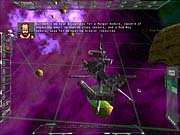
Far Gate uses a traditional mission-based structure, with each mission taking place in a new solar system centered on a sun and unique challenges. There are eight multiplayer maps, but the game's primary focus is its single-player campaign, so it's surprising that there are only 16 missions, two of which also serve as tutorials. In between missions, you travel to other solar systems though wormholes, and it's through those galactic phenomena that enemies often appear during missions, so it'll often be important to blockade the space surrounding wormholes. Often you won't know all of your objectives at the outset of a mission, but the goals will generally consist of establishing and defending a base and destroying enemy forces and installations.
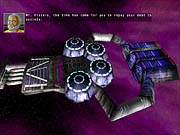
You automatically gain access to more advanced units and structures as you progress through missions, so you don't allocate resources to research new technology. Resource collection is also handled automatically once you've built the requisite mining structure, as each structure comes with its own harvesting craft and they'll dutifully begin mining asteroids.
The build of Far Gate we previewed was a little unpolished in some ways. The pacing of the scripted cinematics can seem intolerably slow, for example, as it often feels like you're forced to wait about five seconds too long between lines of dialogue. The mission loading times are also lengthy, and when you escape to the main menu in order to save the game, you're forced to endure the loading process again before you can resume your mission. The game also doesn't always transition between perspectives as smoothly as it should, even when you're using lower graphical resolutions and when you're using a powerful GeForce 2 Ultra video card. Those quirks may all be addressed prior to the game's North American retail release (although since the game is already commercially available elsewhere, it may already be, substantially, in its final form).
Given the critical and reasonable commercial success of the Homeworld games, it's surprising that a game that's otherwise as polished as Far Gate doesn't have a major North American publisher (it's currently being published by French publisher, Microids). It's a better looking game and appears to be more innovative than Conquest: Frontier Wars, although that game hasn't received much positive press lately, since Microsoft recently elected to not publish that game even though it was substantially completed. Hopefully Far Gate won't be subjected to a similar fate. Far Gate features innovative gameplay, some of the best spaceship designs since Star Control 2, solid graphics, and epic fleet battles. Provided that the developers can iron out the few remaining quirks prior to releasing the game in North America, Far Gate looks like a very promising real-time strategy game.
Got a news tip or want to contact us directly? Email news@gamespot.com
Join the conversation